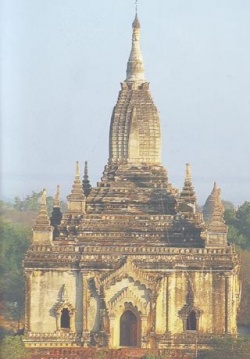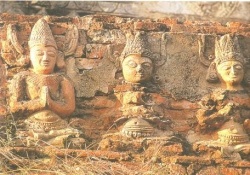Difference between revisions of "Shwegugyi Temple"
| Line 50: | Line 50: | ||
[[Category:Bagan]] | [[Category:Bagan]] | ||
[[Category:Buddhist Temples]] | [[Category:Buddhist Temples]] | ||
| + | [[Category:Buddhist temples in Burma]] | ||
Revision as of 03:12, 15 December 2013
Date: 1131
The Shwegu-gyi affords excellent views of the major monuments within the city walls. The time it took to build was mere seven and half months, important evidence for estimation construction times at Pagan. The dramatic interior illumination heralds experiments developed in the second half of the 12th century. It also is the first dated temple at Pagan to be designed without stone sculpture, an important trend. It was extensively refurbished sometime during the late 18th or 19th century when its original frescos were whitewashed. Its interior stucco work ranks among the best at Pagan.
Visit
The temple is located in the hearted of the Walled City, to the south of the paved road leading form the Tharaba Gate. This and the Pahtothamya are now the only temples inside the city walls with access to the upper terraces.
History and Inscription
The temple was built by King Alaungsithu who, in 1131 succeeded his grandfather the great Kyanzittha, said to be responsible for the Ananda. His donation is recorded on two slabs set into the wall of the sanctum, facing the central image, but this may not be their original location. The temple was begun on April 19, 1131, and finished on December 16, 1131. This information proves that this medium sized temple required only seven and a half months to finish.The inscription is a poem of a hundred Pali verses and records the king’s command: “Make a pleasing lovely room, a fragrant chamber [a=gandhakuto, Pali] for the mighty Seer, Gotama Buddha’’ it is the only inscription at Pagan dated to the Shaka era, a system of reckoning years started in early India. It was rarely used in north India by the time of the Pagan period but was more common in south India.A length painted inscription to the right of the central Buddha is undated but probably belongs to the late 18th or early 19th century. Alaungsithu and includes the name “Paugaramapura”, or the City of Pagan. Another ink inscription inside id sated to January 23, 1771, and records that the entire temple was refurbished (Than Tun, 1996). This work likely included the wooden doors, the crude chapels on the sides of the sanctum, and the first whitewashing of the interior walls.This royal temple points north, another indication that directional orientation was a hard and fast rule at Pagan, at least in the early period. Modern excavations of brick mounds in front of the temple are conjecturally associated with Kyanzitha’s palace.
Exterior
A the rear of the temple was once a glorious row of gods beaming down from the top of the tall foundation wall. Only an handful of glorious row of gods beaming down from the top of the tall foundation wall. Only an handful of these seated, crowned figures survive today, their hands clasped together in homage, but more than fifty were intact as recently as the 1950s. These impressive figures once encircled the building, accented by rounded crenellations, some still filled with green glazed tiles, with a register of bold lotus leaves.
The stucco work on the exterior has been renovated, but original long and pieces can be seen. At the base of many of the doorways are matching niches intended for seated male figures, built of brick and covered with stucco, a feature at the Ananda Temple and other later temples, such as the Sulamani and Dhammayan-gyi.
Each of the entrances has enormous teak double-doorways possibly dating from refurbishment of 1771. The pair facing the shrine has fanciful lions at the top while the others have birds holding stalks in their beaks (see page 132). These doors are likely m the same period as the even larger examples in the Ananda.
Entrance hall
The facade of the entrance hall is framed by restored double-arch pediments. The doorway inside leading to the central sanctum was entirely renewed. In one corner is a short dated stone inscription of King Bayinnaung (1551-1581) from when he was in Pagan raising hit at Shwezigon Pagoda. The inscription was brought from somewhere else relates to land taxes.
Interior
The sanctum interior is dominated by a Buddha seated on a high base within a huge niche formed from the central core. The plan departs from the norm, since the architects made the space facing the Buddha much wider than the side and rear corridors. Also, the enormous vault in front of the principal image springs low, rising steeply near the floor. These devices create the feeling of a separate, spacious area rather than a narrow corridor surrounding the sanctum. In addition, the Buddha figure protrudes into the hall, allowing the worshipper closer accesses to the seated image than if it were deeper inside the niche. This unusual interior space may be appreciated by standing in any corner of the shrine. The interior is well lit, with nine doors and windows. Two small square openings placed high on the wall of the shrine near the Buddha’s head shed additional light. This bright, open interior contrasts to the dark inner sanctums of many temples at Pagan, such as the Kubyauk-gyi in Myinkaba, built in 1113, only 18 years earlier. The addition of side and rear doorways marks the direction in which Pagan builders were moving.
The Shwegu-gyi is the earliest dated temple to show this important feature. Each wall is also pierced by multiple windows, a feature that virtually disappears among later temple, such as the Nandamannya.
There was also no stone sculpture from earlier practices in such temples as the Ananda, Nagayon and many others. This begins a trend at Pagan, and by later in the 12th century few temples were designed with stone images.
The inside was extensively refurbished in the late 18th century. Traces of the original 12th century fresco can be picked out with difficulty beneath the later whitewash, such as parallel rows of seated Buddhas.
The rear of the sanctum wall still preserves its original niche, however, a tour de force of ancient stucco work, with faint traces of original painting. Note the unusual frieze of Kirtimukhas and suspended garlands encircling the base of the outer sanctum wall.
The Roof Terraces
Outstanding stucco work with traces of original paint frames the niche on the rear wall.
Wooden doors were probably part of the refurbishment of the Shwegu-gyi in 1171 and resemble those inside the Ananda Temple.
A staircase in the entrance hall leads to the upper terraces. The tower has been restored recently, but the two lower terraces retain rows of original square green glazed tiles alternating with stucco lotus medallions. This is the first dated us e of glazed ceramics at Pagan, Much re-plastering in modern times has occurred, but some original ornament survives on the small corner shrines






